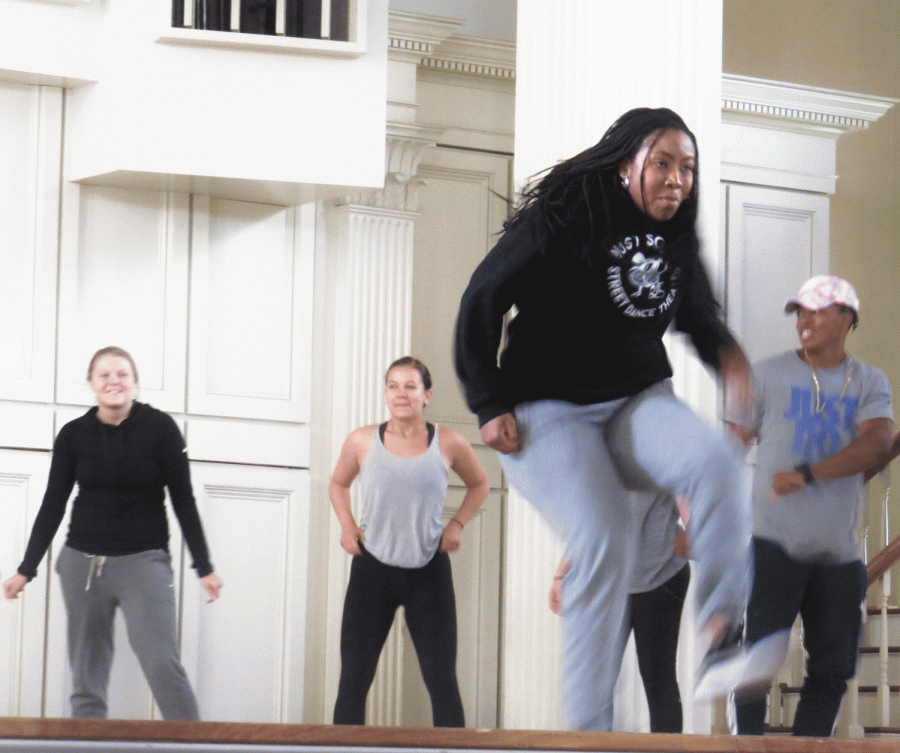International Hip-Hop Artists Discuss Hip-Hop History
On Friday, September 29, Colgate University was joined by internationally-lauded hip-hop duo, Kyle “JustSole” and Dinita “Queen Di” Clark. As part of a week long residency, the Clarks worked with Colgate students in dance groups MELANATED and DDT on various forms of hip-hop dance while also educating the students on the history of hip-hop.
Both Kyle and Dinita graduated from the University of the Arts and danced as principles in the Rennie Harris Puremovement Hip-Hop Theater Company for many years. They have twice represented the United States as international cultural ambassadors, placed in the top 10 in the world championships in Paris and have won the Juste Debout USA 2014 street dance competition in the “2×2 House” dance division.
Kyle and Dinita are committed to preserving the authenticity of hip-hop dance as an inclusive form of self-expression that allows for independence, unity and discipline. The Clarks teach and choreograph for universities across Philadelphia, in addition to running their own street dance and theater company called Just Sole!, which they co-founded in 2010. The pair also continues their mission of empowering and enriching the masses by providing an outlet of expression through their bi-monthly workshop series called “Funky Sole Fundamentals,” which they started in 2011 to preserve the styles of hip-hop, house and funk. The Clarks also run an annual street dance competition in Philadelphia called Soul 2 Sole.
Hip-hop is an umbrella term; there are several interpretations of the art form.By definition, “hip” refers to one who is knowledgeable, or in the know, while “hop” refers to a dancer or a club of dancers. Together, hip-hop is a group of intelligent dancers, as Kyle explained. The culture of hip-hop has four key components: a Mic Controller (MC), a Disc Jockey (DJ), graffiti artists and knowledgeable dancers. These elements can be traced as far back as 10,000 years ago in Africa, where there were two drummers, a tribal or ritual dancer in the middle and a group of other dancers on the outside. Nowadays, one can see two DJs in the club, a street dancer in the middle and a group of people dancing around the dancer.
Dance and movement is a reflection not only of music, but also of the social and economic time periods during which people are dancing. People move to show how they feel when others will not listen or do not understand their voices. Kyle “JustSole” began the hip-hop lecture in Los Angeles, 1970. During this time, 19-year-old Don Campbell premiered on the TV show “Soul Train.” Meanwhile, the Lockers dance group was created, which was the very first street dance team to perform on television. Kyle iterated that a style of dance cannot be created without a foundation; all dance starts with a social dance, which builds on top of other social dances, and then becomes technique. There is nothing that is wrong or right – dance is like art, and it is in the eye of the beholder. The first style of hip-hop that the Clarks and Colgate students demonstrated was locking: a picturesque, posing form of isolated movements.
The next era of hip-hop came in 1975 with the music of George Clinton. Dancing reflected the public’s fascination with space travel, as seen in “Star Trek” and Star Wars. Movements such as fresco (locking and moving your muscles) and dime-stopping (stopping quickly) emerged. Sam Solomon and the Electric Boogaloo group made real contributions to the style of popping: the constricting and releasing of your muscles while dancing. Some variations on this style are ticking, scarecrow and tutting. Colgate students and the Clarks had a great time demonstrating their choreography for popping.
In the Bronx in 1977, the hip-hop renaissance was taking off. Breaking came about because of funk music. BBoy or BGirls were created: the terms stood for Bronx boy/girl, boogie boy/girl, and/or break boy/girl. BBoy-ing is a culture that is more than a dance; it is the hat you wear, the shoes you buy and the slang you speak. Additionally, the TopRocket social dance became popular during this time period.
In the 1980s, hip-hop music was comprised of eight track samples of classic funk records. Each authentic track featured a sample funk beat with an MC over the top. Hip-hop and house music began to fuse together and incorporate the forms of African, funk, Latin and tap beats. As the music headed in a new direction, hip-hop did too. Authentic hip-hop featured a bounce groove; house dance included styles such as looseleg and skates at a faster tempo.
As Kyle Clark stated, hip-hop is an inclusive culture; it is pedestrian by nature and connects anyone and everyone as dancers through emotion and spirituality. With an open mind and heart, one can learn anything, even hip-hop.
Contact Caylea Barone at [email protected].
Caylea Barone is a senior from LaGrangeville, New York concentrating in environmental studies and art and art history with an emphasis in studio art. She...







